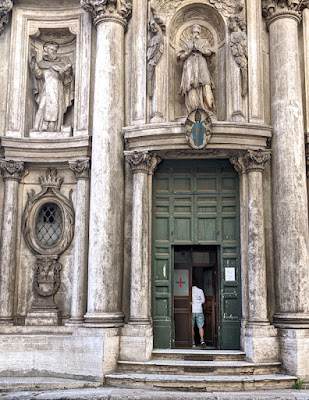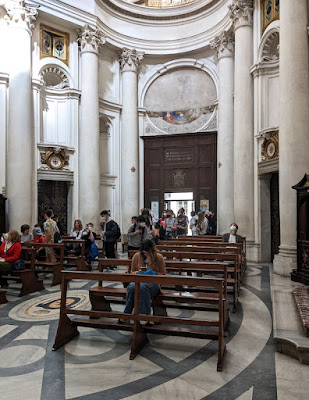When you are walking in Rome on Via del Governo Vecchio you may look up and see this delightful clock tower
by Francesco Borromini: a genius of the Roman Baroque.The clock tower is around the back of this building, called the Oratorio. The scalloped front is very Borromini -- he didn't do flat walls, as you will see.
Closer look at the central front door of the Oratorio. Notice there is lots of play between elements coming forward and elements dropping back. The details are beautiful.
Across town and up the Quirinal Hill is Borromini's San Carlo alla Quattro Fontane (called affectionately: San Carlino): same play of volumes and beautiful details.
San Carlino: door to the sacristy. The subtlety of the decorations is great fun.
Borromini liked to show off his command of geometry.
Notice San Carlino lacks flat walls. Instead it has pillars and cornices. Borromini did not like to be bored.
Inside San Carlino, looking toward the entrance.
Even the hallways in San Carlino are memorable.
Now the sacristy, this room, with its beautiful ceiling used to be the dining room for the monks.Across town again, to Sant'Ivo alla Sapienza (St Ivo of Wisdom): Borromini's masterpiece. This is the view of the courtyard from the street.
The walls culminate in a dazzling dome,
from a six sided floor plan. It is a good place to spend Sunday morning in Rome.
Find St Ivo midway between the Pantheon and Piazza Navona. The hours are literally carved in stone outside: Sundays: open 9 a.m. to 12. Mass at 10 a.m.
One last masterpiece. Do you remember the square staircase Bernini designed for Palazzo Barberini? Borromini designed this staircase at the other end of the building.A miracle of talent and perfect taste. Bill and I became very interested in Borromini on this trip. We look forward to visiting all his sites again soon.
























































%209th%20century.jpg)




